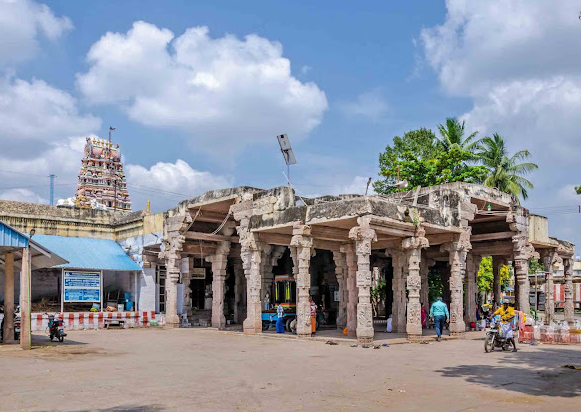According to the local history (Sthalapurana) of Thiruchuzhi, Lord Shiva is believed to have condensed the Pralaya floods into a water bubble and covered it with earth at this very place, giving it the name Thiruchuzhial.
Sthala Puranam :
During the Dwapara Yuga, there were devastating floods (pralayam) in this region that threatened the lives of the people. The ruling king, a devoted follower of Lord Shiva, prayed earnestly to Shiva for the safety of his subjects. Pleased with his devotion, Shiva hurled his Trisulam (trident), creating a hole in the earth through which the floodwaters drained away. This divine incident is believed to have given the place its name Chuli or Chuliyal, referring to the whirlpool and swirls created by the trident. A separate shrine for Shiva as Pralaya Vitangar is present in the temple to commemorate this event.
There is also a connection between this temple and Chidambaram. When Sundarar visited this place, Shiva appeared to him in a dream as a youthful figure holding a golden bouquet and sporting a frontal tuft of hair (Munkudumi), similar to the hairstyle worn by the Deekshitars of Chidambaram. The next morning, Sundarar, along with Cheraman Perumal, visited the temple to pay homage.
The following verse reflects the sentiment about Kumbakonam and Tiruchuli:
अन्य क्शेत्रे क्रितम् पापम् पुण्यक्शेत्रे विनश्यति |
पुण्यक्शेत्रे क्रितम् पापम् वारानास्याम् विन्श्यति ||
वारानास्याम् क्रितम् पापम् कुम्भकोणे विनश्यति |
कुम्भकोणे क्रितम् पापम्, कुम्भकोणे विनश्यति ||
This verse means: "The sins committed in any place are washed away at a holy place. Sins committed at holy places are washed away only at Varanasi. Sins committed at Varanasi are washed away at Kumbakonam, and sins committed at Kumbakonam are washed away only at Kumbakonam." There is a similar belief about Tiruchuli as well.
Parvati is said to have meditated upon Shiva here to seek His hand in marriage. Possibly depicting this, Parvati’s shrine is located to the right of the Garbhagriham (sanctum), both facing east, in a Kalyana Kolam (marriage posture). In the past, it is believed that the celestial couple appeared in their wedding attire to devotees, making this temple a Prarthana Sthalam (place for prayers) for those seeking marriage.
Among the various names of the Moolavar (main deity) are Dinakareswarar (as He was worshipped by Suryan) and Bhoominathar (after Bhudevi worshipped Him here). The place is considered equivalent to Mount Meru.
Given its association with the core tenets of Shiva worship, it is believed that worshipping here with one Vilvam leaf is equivalent to worshipping with 1000 Vilvam leaves at all Shiva temples across the land. Additionally, worshipping Bhoominathar here is believed to help resolve land-related problems of the devotees.
It is believed that Lord Shiva Himself chose to come here because He considered it more glorious than Kailasam. Devotees thus consider this place as sacred and fit for worship, on par with Kailasam.
The temple was originally built by the Pandyas and has seen subsequent additions from various dynasties that ruled over the region of Pandya Nadu. Over the years, the rulers of Ramanathapuram have maintained this temple, ensuring its continued significance and upkeep.
Administration History :
The Thirumeninathar Temple was reconstructed and expanded during the Pandya, Chozha, and Vijayanagara periods. Inscriptions indicate that Parakrama Pandyan built the Sanctum Sanctorum, and Sundarar's Thevaram mentions the temple's tall vimana. After the Vijayanagara period, the temple underwent further renovation by the Nattukottai Nagarathars. The temple is currently under the administration of the Nattukottai Nagarathars, who oversee its maintenance. The temple management ensures its preservation and regular rituals.
